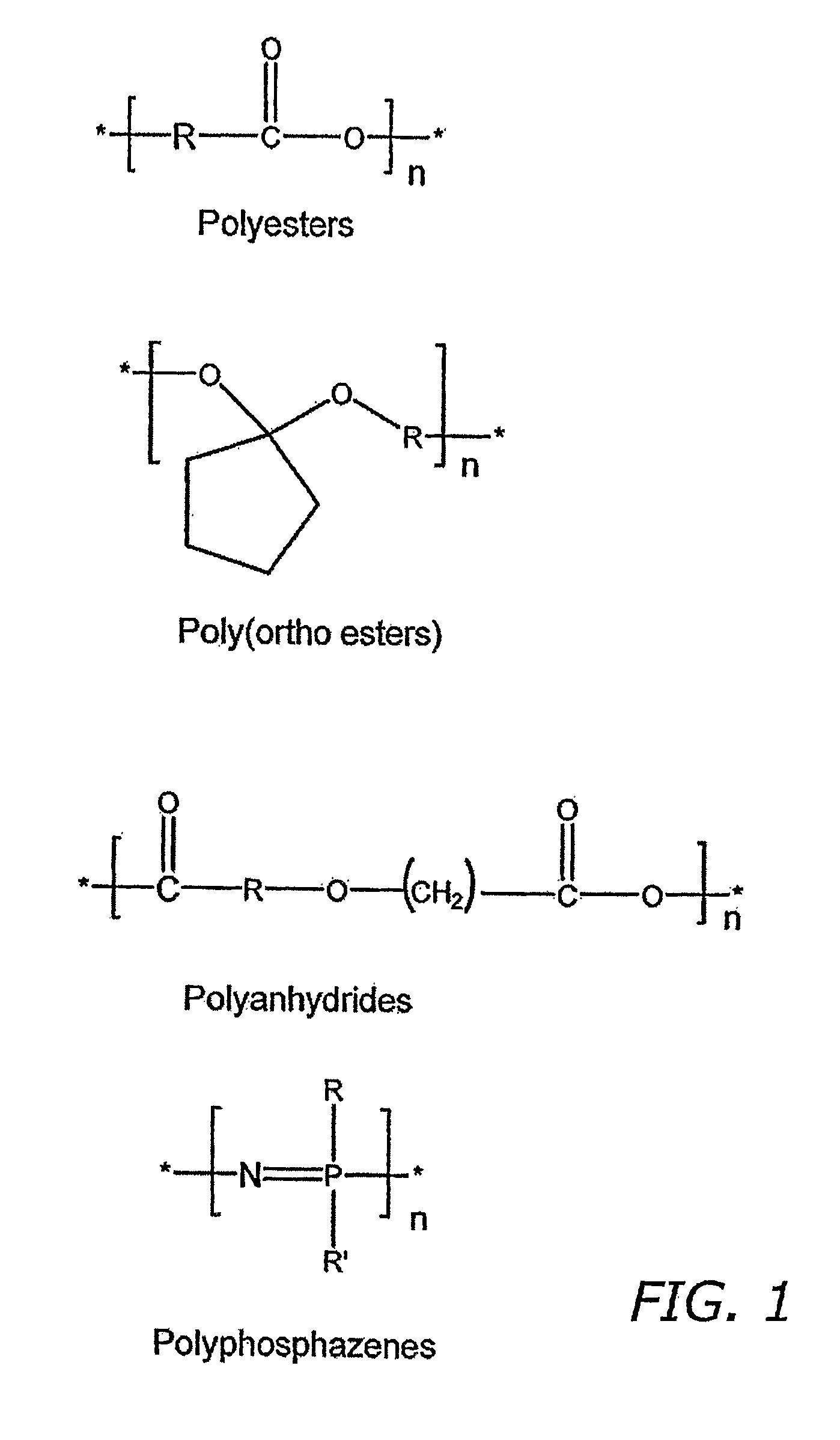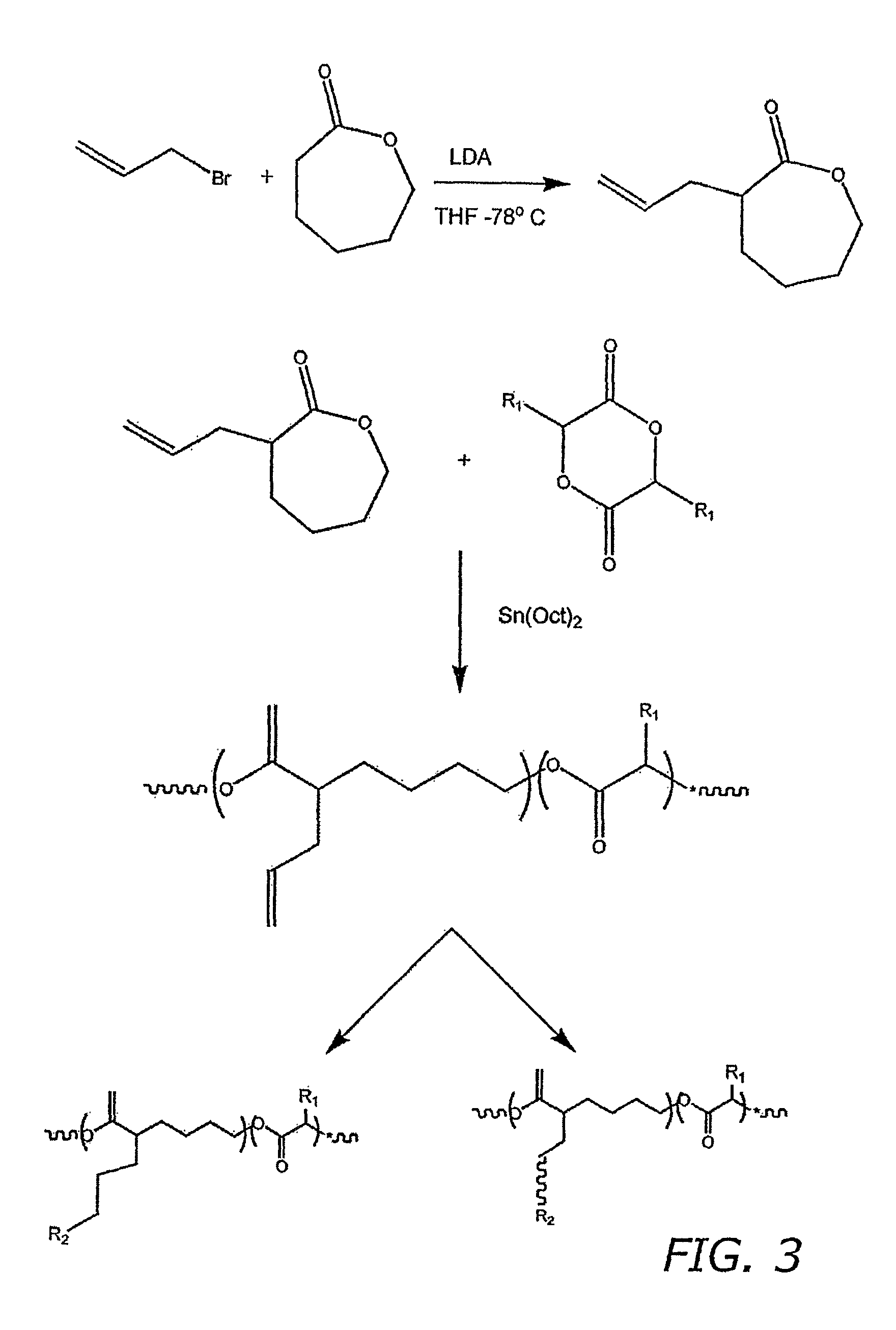Medical devices and coatings therefore comprising biodegradable polymers with enhanced functionality
a biodegradable polymer and functional technology, applied in the field of medical devices and coatings comprised of biodegradable polymers, can solve the problems of limited application, limited material scientist's options, and relatively slow biodegradation rate, and achieve the effect of increasing hydrophilicity and enhancing mechanical properties of polymers
- Summary
- Abstract
- Description
- Claims
- Application Information
AI Technical Summary
Benefits of technology
Problems solved by technology
Method used
Image
Examples
example 1
Acrylic Functionalized Polyester Backbones
[0073]A) Monomer Synthesis
[0074]In a 500 mL tri-neck round-bottom flask add 10 mL of N,N-diiopropylamine and 300 mL of tetrahydrofuran (THF). Stir under nitrogen and cool in a dry ice isopropyl alcohol bath. To this reaction mixture add 24 mL of N-Butyl Lithium by syringe drop-wise and stir gently for 15 minutes. Next 30 mL of 20% (vol / vol) solution of δ-valerolactone in THF is added drop-wise over a 1 hour period, gently stir for 30 minutes and then 30 mL of a 20% (vol / vol) allyl bromide solution in THF is added drop-wise over 1 hour while gently stirring. Continue to gently stir the reaction mixture for 2 hours. Next 6 mL of a saturated ammonium chloride solution is added and the reaction mixture is allowed to warm to room temperature. Next volatiles are removed by rotary evaporation. The remaining solid is dissolved in ether, washed in saline and diluted with hexane followed by a second saline wash. The reaction product is then eluted thr...
example ii
Hydroxyl Functionalized Polyester Backbones
[0081]A. Preparation of Oxo Functionalized Polyester
[0082]Cyclohxane 1,4 dione (CAS Reg Number 637-88-7) is reacted with m-chloroperbenzoic acid (m-CPBA CAS Reg Number 937-14-4) to yield the seven member heterocyclic dione oxepane-2,5-dione. This seven member heterocyclic dione is then reacted with a cyclic di-ester, 3,6 dimethyl-[1,4]dioxane 2,5 dione (D,L-Lactide) (CAS Reg Number 30846-39-0), in the presence of the ring opening catalyst Sn(Oct)2 resulting in a ring-opening polymerization as depicted in FIG. 2.
[0083]B. Adding Hydroxyl Functionality
[0084]The polyester polymer is then modified to contain a hydroxyl group. This is done via known oxidation and / or hydroxyl adding processes. For example, it is well known that ketones can be reduced to secondary alcohols through nucelophilic addition (reduction) of the oxo group using hydride reagents such as, but not limited to LiAlH4 and NaBH4. It is understood that where more than one oxo is p...
PUM
| Property | Measurement | Unit |
|---|---|---|
| solubility | aaaaa | aaaaa |
| weight percent | aaaaa | aaaaa |
| thick | aaaaa | aaaaa |
Abstract
Description
Claims
Application Information
 Login to View More
Login to View More - R&D
- Intellectual Property
- Life Sciences
- Materials
- Tech Scout
- Unparalleled Data Quality
- Higher Quality Content
- 60% Fewer Hallucinations
Browse by: Latest US Patents, China's latest patents, Technical Efficacy Thesaurus, Application Domain, Technology Topic, Popular Technical Reports.
© 2025 PatSnap. All rights reserved.Legal|Privacy policy|Modern Slavery Act Transparency Statement|Sitemap|About US| Contact US: help@patsnap.com



